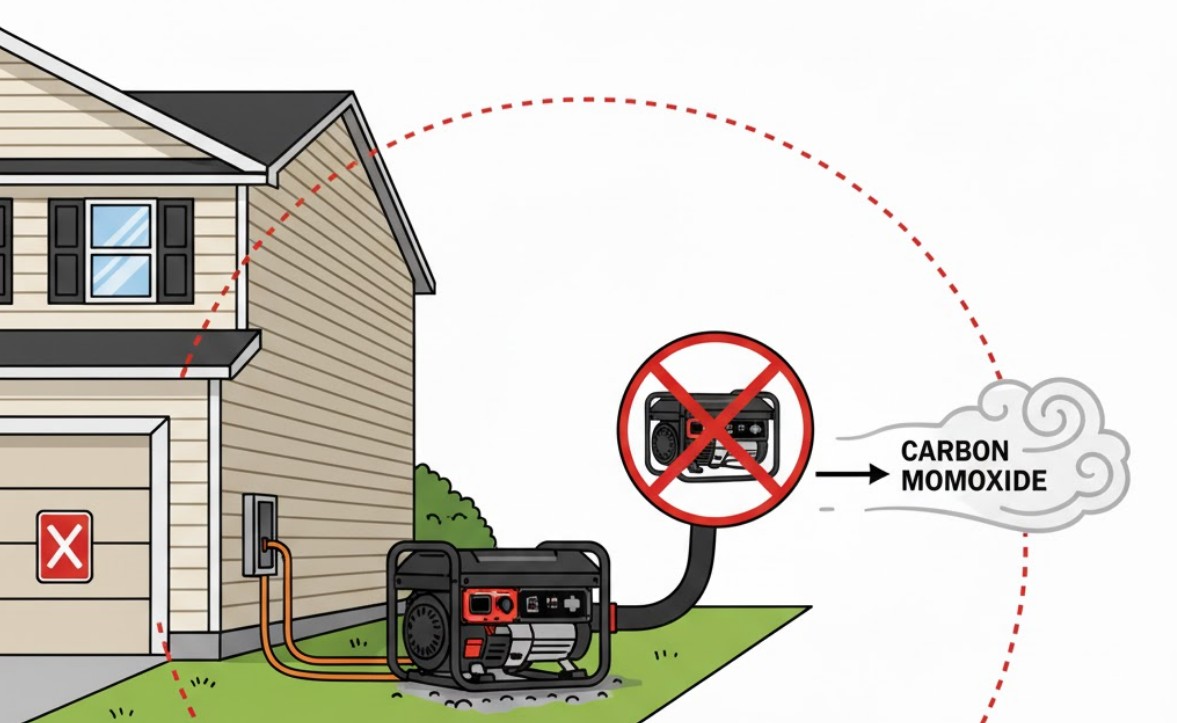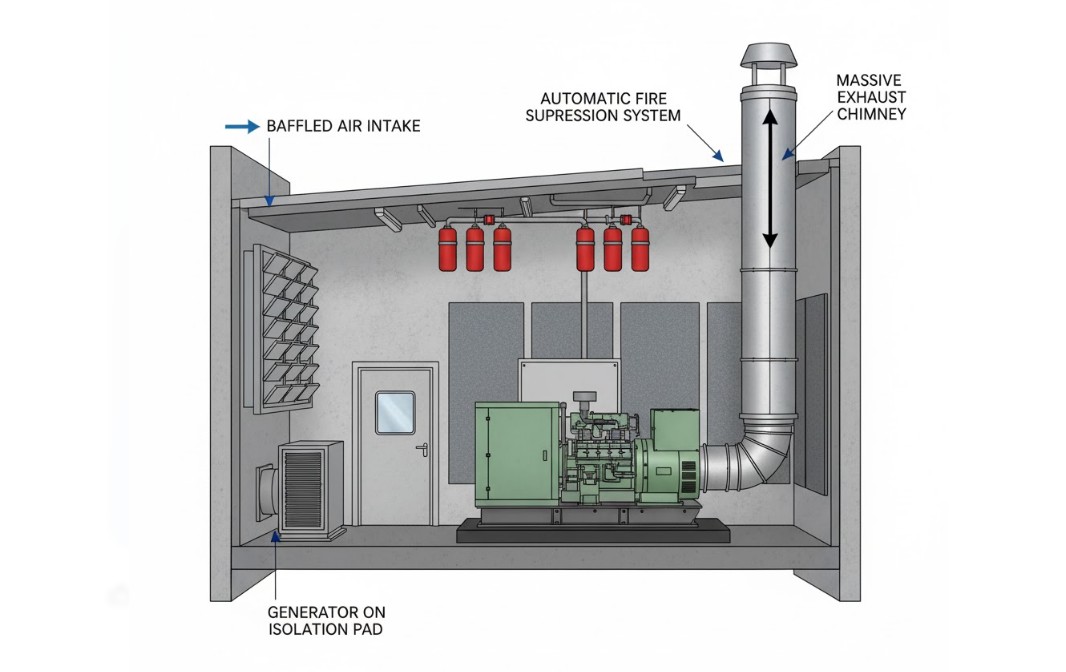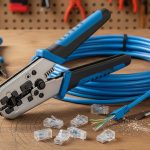This comprehensive guide will delve deep into the pros, cons, and essential regulations surrounding both indoor generator placement and outdoor generator placement. We’ll cover everything from legal zoning restrictions to the nuances of noise abatement and maintenance accessibility, ensuring you have all the information needed to make a safe and informed decision.
The Non-Negotiable Rule: Understanding Carbon Monoxide
Before exploring the specifics of Indoor Vs Outdoor placement, there’s one paramount, non-negotiable rule: Never run a portable generator indoors. This includes garages, sheds, basements, carports, or any partially enclosed space. Generators produce carbon monoxide, an odorless, colorless, and deadly gas.
According to the Consumer Product Safety Commission (CPSC) and countless safety organizations, the exhaust from a generator can quickly reach lethal concentrations in an enclosed space. Even opening doors and windows isn’t enough to prevent CO build-up. Tragically, numerous fatalities occur annually due to improper generator placement. Therefore, when discussing Generator Placement: Indoor Vs Outdoor, the “Indoor” context must be strictly limited to standby generators permanently installed in compliance with all local codes and featuring specialized, manufacturer-approved exhaust venting systems designed for such applications. For portable generators, the placement discussion is unequivocally Outdoor.
Portable Generators – The Outdoor Imperative
For the majority of homeowners and business owners who rely on portable generators for temporary power during outages, the decision is simple: the unit must operate outdoors. However, “outdoors” isn’t just any spot in the yard. Precise outdoor generator placement is crucial for safety and functionality.
The Critical Safety Distance
The most vital factor in outdoor generator placement is the distance from your home or any adjacent structure. A minimum safe distance is necessary to prevent CO from entering living spaces. Most manufacturers and fire departments recommend a minimum of 20 feet (approximately 6 meters) away from all doors, windows, and vents. This distance helps ensure that prevailing winds and natural air circulation disperse the exhaust effectively before it can infiltrate the building envelope. Furthermore, always position the unit so that the exhaust is directed away from the building.

Protection from the Elements (and Theft)
While the generator must be outdoors, it still needs protection from rain, snow, and direct sunlight to function reliably. Many people mistakenly think they can run a portable generator under a porch or a partially open garage door; this is deadly and illegal. The solution lies in specialized covers, generator tents, or purpose-built generator enclosures designed to shield the unit from moisture while maintaining complete, unrestricted airflow for safe exhaust venting and cooling. Never cover a running generator with a non-approved tarp or place it in an enclosed doghouse-style structure without certified venting.
Noise Considerations for Outdoor Use
A significant drawback of outdoor generator placement is the noise. Portable units can be quite loud, often exceeding 70-80 decibels. When determining your spot, consider the direction the noise travels and how it might impact neighbors. Placing the unit on a soft surface, like grass or an anti-vibration mat, can help slightly dampen the noise transmission. Keep in mind that many local municipalities have noise ordinances that dictate the maximum permissible decibel level at the property line, especially during nighttime hours. Distance is the best sound-dampening tool you have in your arsenal when it comes to portable units.
The Role of Extension Cords in Portable Placement
Since the unit must be at least 20 feet away, you need a safe way to connect it to your home’s electrical system or appliances. This is where high-quality, heavy-duty generator extension cords come into play. Always use cords specifically rated for outdoor use and sized correctly (12-gauge or thicker is common for high-power demands) to avoid overheating and fire hazards. Never run cords under carpets or through doorways that can pinch the wiring. For an overview of different power options, including quieter models, you might want to read about the types of generators.
Standby Generators – The Permanent Placement Solution
Standby generators are designed for permanent installation, much like a central air conditioning unit. They are the true focus of the Indoor Vs Outdoor debate for permanent power solutions, though the vast majority are installed outdoors.
The Standard: Permanent Outdoor Installation
The overwhelming preference for standby generator placement is outdoors. These units are encased in weather-resistant, usually sound-dampening, enclosures. The outdoor placement is simpler, safer, and less costly because it eliminates the need for complex, code-compliant indoor venting systems. Installation must still follow local zoning and fire codes regarding distance. Typical requirements include:
- Minimum Distance from the House: The National Fire Protection Association (NFPA) requires at least 1.5 feet from the structure, but many local codes and manufacturers’ warranties mandate 5 feet or more.
- Clearance from Windows/Doors: Standby units generally cannot be located within 5 feet of any window or door to prevent CO infiltration, even with their directed exhaust.
- Clearance from Combustibles: Adequate clearance from shrubs, gas meters, propane tanks, and other flammable materials.
- Accessibility: Positioning the unit where an electrician, fuel plumber, and maintenance technician can easily access it.
Fuel Source and Placement Implications
The fuel type of your standby generator (Natural Gas, Propane, or Diesel) significantly influences placement. Natural gas units must be located relatively close to the existing gas meter to minimize plumbing costs. Propane units require clearance from the fuel tank, often dictating the generator’s final position. Diesel units, which rely on an integrated or external fuel tank, have more flexibility in placement but introduce fire and spillage considerations. To learn more about the units themselves, check out the best home standby generators available.
Level Ground and Base Requirements
A key element of successful standby outdoor generator placement is ensuring a level, stable base. Most manufacturers require the unit to be installed on a sturdy, non-combustible pad, typically reinforced concrete, composite pads, or crushed gravel. This prevents the generator from settling unevenly, which can damage the engine, fuel lines, and electrical connections. It also helps to minimize vibration transmission, a factor in reducing overall noise pollution.
The Rare Exception: Certified Indoor Generator Rooms
While not an option for standard residential applications, certain commercial, hospital, or specialized industrial settings might require a generator placement indoors. This is an incredibly complex, expensive, and code-heavy undertaking that requires specialized design by engineers.
Indoor Installation Requirements
An indoor generator room must adhere to the strictest fire and building codes. Key requirements include:
- Dedicated Space: A specific, often fire-rated, room solely for the generator, typically separate from other mechanicals.
- Advanced Ventilation: A sophisticated, often automatically controlled, ventilation system is needed for cooling the unit and expelling the dangerous exhaust. This includes intake vents for fresh air and high-capacity exhaust vents for heat and CO.
- Fuel Storage & Delivery: Safe, code-compliant handling of fuel lines (natural gas) or on-site fuel tanks (diesel), often requiring specific room materials and fire suppression systems.
- Noise Dampening: Significant sound attenuation is usually required to prevent noise transmission throughout the building, involving acoustic louvers, baffles, and heavy-duty insulation.
Proper ventilation is the single most important factor for any indoor unit. Learn more about proper ventilation for generators.
Cooling and Air Intake Challenges for Indoor Units
Unlike outdoor generator placement where ambient air handles cooling, an indoor unit requires massive airflow. The room must be engineered to provide enough fresh air to cool the engine and alternator while also supplying oxygen for combustion, all without creating negative pressure that could pull CO back into the room. This engineering complexity is a major reason why outdoor placement is universally preferred when possible.

A Comparative Look: Indoor Vs Outdoor Placement
To summarize the fundamental differences in Generator Placement: Indoor Vs Outdoor, consider this comparison table, which focuses on the typical applications (Portable/Outdoor Only and Standby/Outdoor Preferred):
| Factor | Portable Generator (Outdoor Only) | Standby Generator (Outdoor Preferred) |
|---|---|---|
| Carbon Monoxide Risk | High if placed too close (under 20ft) or near openings. Requires 20-foot minimum clearance. | Low when installed correctly (exhaust directed away, proper distance from windows/doors). |
| Noise Level | High (70-90 dB). Harder to mitigate without enclosures. Placement distance is key. | Moderate (55-70 dB). Designed with integrated sound-dampening enclosures. |
| Weather Protection | Requires external accessory (tent, cover, or approved enclosure) to operate in rain/snow. | Fully weatherproof enclosure is built-in by the manufacturer. |
| Installation Cost/Complexity | Low initial cost; complexity is in safely routing extension cords and placing 20ft away. | High initial cost; complex installation involving electrical, plumbing, and permitting. |
| Fuel Management | Manual refueling required; fuel storage poses a separate safety risk. | Automatic, permanent connection to Natural Gas or Propane line (minimal user intervention). |
| Maintenance Access | Simple access. | Panels designed for technician access; often requires clear surrounding clearance. |
Optimizing Outdoor Placement for Safety and Longevity
For the vast majority of generator owners, the reality is that their unit will be permanently or temporarily placed outdoors. Optimizing this placement is a balance between safety, convenience, and performance.
Managing the Electrical Connection
The safe transmission of power from the generator to the house is essential, especially with the mandatory 20-foot distance for portable units. The safest and most efficient connection method is using a manual transfer switch installed by a licensed electrician. This switch allows you to safely back-feed power to specific circuits in your home without the risk of connecting the generator to the main utility lines (a dangerous mistake known as “backfeeding”). Using a transfer switch eliminates the need to run messy, temporary extension cords through windows or doors, which compromises security and weatherproofing. (Internal Link: To ensure you are using the correct accessories for a safe connection, review our guide on the best generator extension cords.)
Ground Stability and Vibration Mitigation
Whether portable or standby, the generator should always rest on a solid, level surface. For portable units, this means a concrete pad, paved area, or even a thick sheet of plywood over gravel. Never operate a generator on grass, dirt, or decking. Running on soft ground causes uneven vibration, which can lead to premature wear on internal components and fuel line stress. For standby units, a professional-grade pad is mandatory to ensure the unit remains level and secure throughout its operational life.
Final Thoughts
The choice between Generator Placement: Indoor Vs Outdoor is almost always dictated by the generator type, with portable units requiring non-negotiable outdoor placement and standby units overwhelmingly favoring permanent outdoor installation for safety, cost, and practicality. The singular, critical takeaway is this: Safety must always be the top priority. Carbon monoxide is an invisible killer, and the industry-standard 20-foot minimum distance for portable generators is a life-saving recommendation, not a suggestion. By adhering to manufacturer guidelines, local building codes, and basic common-sense principles—especially regarding exhaust direction and distance from openings—you ensure your generator is a reliable backup tool, not a hidden hazard. Plan your placement with care, secure your connections with precision, and you can face the next power outage with confidence.
Amranul is a highly experienced product review writer with a passion for helping readers make smart, informed purchasing decisions. Since 2018, he has specialized in thoroughly researching and analyzing a wide range of products to deliver honest, in-depth reviews. Amranul combines technical accuracy with clear, engaging writing to break down complex product features and highlight true user value. Look for his reviews to find reliable information and expert insights you can trust before you buy!





